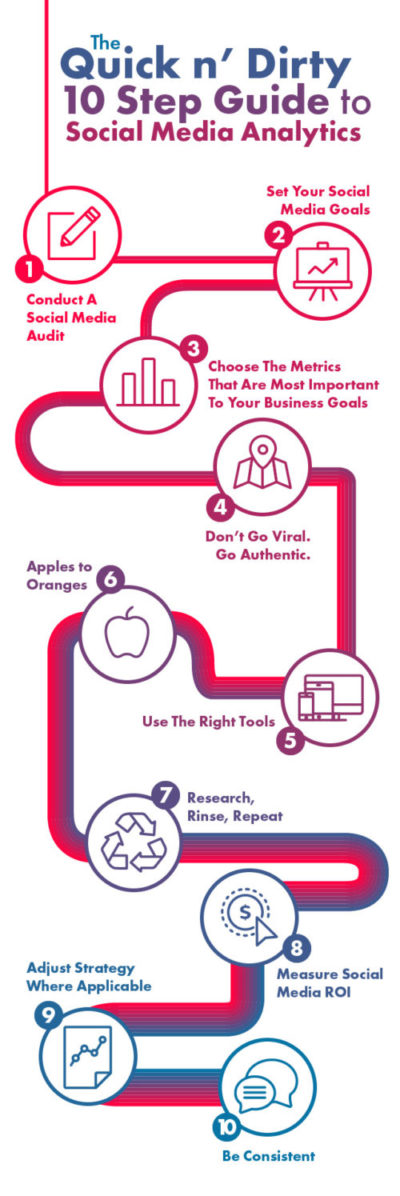Some may read this article title and think, “Analytics? No thank you.” Most people are intimidated by numbers and data—and for good reason! But we’re here to crush those fears and help you become a pro at analyzing the success of your social media efforts with our Quick n’ Dirty 10-Step Guide to Social Media Analytics.
Are you a small business owner or marketing professional mystified by how to measure success when it comes to social media? We’ve got a few tried-and-true numbers you can look at to determine what success looks like.

1. Conduct A Social Media Audit
See what has worked in the past and what hasn’t. Are there other accounts out there floating around with your business name? This is more common than many people realize. Try and consolidate your accounts so that you can have a unified brand across social platforms.
2. Set Your Social Media Goals
Make your goals more specific than “to increase profits.” At the end of the day everyone would like a more profitable business. What specifically do you want to accomplish with your social media accounts? Are you trying to direct people to your website? Are you trying to increase brand awareness through Facebook? Do you want to earn more organic traffic?
Many people think about social media as a lead-generating tool—and that’s a worthy aim—but it’s not always the most important goal. How does your social media reflect your company culture? How does it help recruit new employees? Does it assist you in meeting customer service goals? Set smart goals based on what you’re trying to achieve and identify smaller steps to achieve them.
3. Choose The Metrics That Are Most Important To Your Business Goals
Are impressions, likes, clicks, or conversions—or a combination of them—going to help you reach your goals? If branding or community awareness is your goal, impressions or reach might be the number to pay attention to. If you’re just trying to generate leads, look to conversion tracking via a pixel for answers. A conversion pixel is a JavaScript code that you can insert into your website to track the actions of users and is extremely useful for gathering data about your users and how they are interacting with your business.
4. Don’t Go Viral. Go Authentic
There are few companies who can truly benefit from a piece of content spreading like wildfire. Small businesses tend to not be among them. If a local plumber goes viral it likely won’t help him all that much. After all, who cares if someone in Los Angeles watches your social media video? You’re a plumber in Baton Rouge! Don’t let the allure of social media trick you. We’re here to be authentic, to represent your business, not to become famous.
5. Apples to Oranges
It can be tempting to compare your social media accounts to others, especially if you see them flourishing while you’re feeling like you’re floundering. Remember to compare apples to apples. If a company is 15 times larger than yours with a social media account that’s 10 years old, they’re naturally going to have more traction.
6. Use The Right Tools
You need the right tools to do the job correctly. This could be a platform’s built-in analytics tool, a stand-alone app, or a single source management system. Invest some time into researching the right tools to help you track and achieve your goals. Small steps pay off, remember?
7. Research, Rinse, Repeat
Scoping the social media landscape of your competitors and industry leaders is a great way to discover potential strategies for your social media efforts. You don’t have to reinvent the wheel here! Find which proven strategies align with your goals and brand identity and craft a social media presence that is uniquely yours. (And yes, this is your excuse to do some major social media stalking.)
8. Measure Social Media ROI
Find the value of your efforts. How much money and time did you dedicate to social media? How many conversions, sales, or leads did you garner? Now compare those numbers to calculate your return on investment (ROI). Do you feel it worth the effort and resources you put in?
9. Adjust Strategy Where Applicable
After reviewing your ROI and the results of your social media efforts, you may need to reevaluate your strategy and methodology. Don’t be afraid to take calculated risks or test different ideas and methods. Sometimes you have to think outside of the box while applying known social media strategies.
10. Be Consistent
The best way to successfully decipher social media analytics is to be consistent. Make sure you look at your data regularly and make changes as needed. This is the best way to create a stable social media network that will continue to grow. Trust the process and don’t be afraid to get down and dirty with the data.
Let Us Guide You On Social Media Analytics
Still have questions? That’s okay! Gatorworks is happy to be your guide on how to champion your social media accounts and dive deeper into social media analytics. Contact us at 225-924-6109 or fill out the form below.